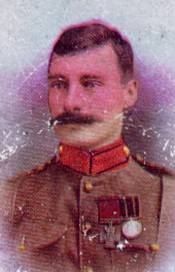"The military honours bestowed upon me are the property of the men of my unit as well as myself and were obtained at considerable cost of the blood of this country. Under no circumstances could I consent to any material gain for myself for my services."-
Captain Charles Upham, Victoria Cross and Bar,
one of only three recipients to have ever won the Victoria Cross twice. The other two being Lieutenant Colonel
Arthur Martin-Leake (picture right) and
Noel Godfrey Chavasse.

Those words and temperament of character from New Zealand's greatest war hero are ones that his three daughters are having just a tad
difficulty living up to. We learn that they have received a million dollar offer from Australia and one worth almost three times that much from a British collector, and have given the New Zealand Government a chance to match it. I suggest the taxpayers of New Zealand cough up the cash because these three have obviously forfeited their right to hang such honour in their house, now that Charles Upham has died (he passed away in 1994). Besides, the price seems to be what the market can bear, since we also learn the other day that the VC of Australia’s most decorated Gallipoli veteran, Captain Alfred Shout, fetched the record price of $1 million (AUS). So I suppose it stands to reason that inheritors of a double VC should get at least double the cash.
Only it doesn’t stand to reason. The Victoria Cross is priceless. It is first in the order of precedence, ranking higher than any order of chivalry, be it the Order of Canada, the Bath, the Garter, be it the
Supreme Order of Christ. I submit that if there is one thing worse than cash for peerages, it is
cash for VCs. Granted the buyers and sellers of VCs are not, as such, trading in honours (they are not paying to
be a VC holder, only to
own the VC), but it’s still not keeping in the spirit of the medal’s true value. The Victoria Cross is no mere trinket. The British Commonwealth’s highest award for valour and gallantry “in the face of the enemy” represents the life and blood of nations. It is sacred. It should not be for sale.
King George V felt so strongly about this, he ordered that no matter the crime, no authority could ever strip a man of his VC, commenting that a recipient should still be permitted to wear the decoration even if he were on the gallows. (His Private Secretary stating in a letter the King's view that:"no matter the crime committed by anyone on whom the VC has been conferred, the decoration should not be forfeited. Even were a VC to be sentenced to be hanged for murder, he should be allowed to wear his VC on the scaffold.")
Had he the foresight, Emperor George would no doubt have widened this policy to forbid the auctioning off of VCs too, much as one cannot auction off one’s citizenship. We cannot sell our passport because we do not own it; we are merely passport holders. Ditto for the Victoria Cross. Recipients of the VC are often described as winners or holders of the award, not owners. The comparison is valid, I think, since heroism in the face of a nation’s enemies represents the highest act of citizenship. It seems to me that there is a special responsibility to protect the dignity of these gallant acts, and not cheapen them by selling them off to the highest bidder.
The grandson of Alfred Shout, Graham Thomas, who sold the medal last week, said keeping the VC in his family home had become too much of a responsibility. He also needed the funds to help his children and grandchildren, and to pay medical bills. "Anyway, I think Captain Shout would support my decision to sell it to support his descendants".
Too much of a responsibility. Well, Captain Shout certainly knew a lot about responsibility, not to mention the sacrifice responsibility sometimes requires. Not sure hanging a VC on your wall of honour constitutes a grave responsibility or an immense joy, but I’m thinking the latter more than the former. As for the brave soldier somehow agreeing from his grave with the decision of his grandson to get rich off his heroism by selling the family jewels to a private collector, I’d have to say don’t think so. It is more likely that Graham is expressing seller’s remorse and is conveniently trying to lessen the guilt he feels for his actions.
But all of this is important now not because of principle alone. It so happens that this year, the 150th year of the Victoria Cross, we continue to find ourselves in the thick of our still unfolding history. Last week, the Americans, Brits and Canadians were engaged in pre-dawn offensives against hundreds of Taliban. Obviously we are still carrying out operations “in the face of the enemy”. We are witnessing our soldiers being killed on a weekly basis, meaning that the winning of a VC is still very much within the realm of
possibility. All this is to say that soldiers are required to wear their medals when in uniform. For them, selling them is not an option. So why should it be an option for their offspring? Why should those who buy it be able to sell it again for even more? Why should a man profit from another man's courage?

 This is an idea that is long overdue. Reservists who volunteer for active duty should have legislated protection to ensure their job is waiting for them when they return.
This is an idea that is long overdue. Reservists who volunteer for active duty should have legislated protection to ensure their job is waiting for them when they return.











